This past weekend’s Cartoon Crossroads Columbus was a celebration of not just comics but cartooning in all its many forms. One of the most vital of those forms is that of newspaper comics, and CXC held a spotlight panel on Saturday featuring some of the big names of that industry. Moderated by Shena Wolf, Director of Comics Development at Andrew McMeel Universal, the panel included Heathcliff cartoonist Peter Gallagher; Heart of the City creator Steenz; Flash Gordon writer/artist and Sally Forth artist Jim Keefe; and Where I’m Coming From creator Barbara Brandon-Croft.
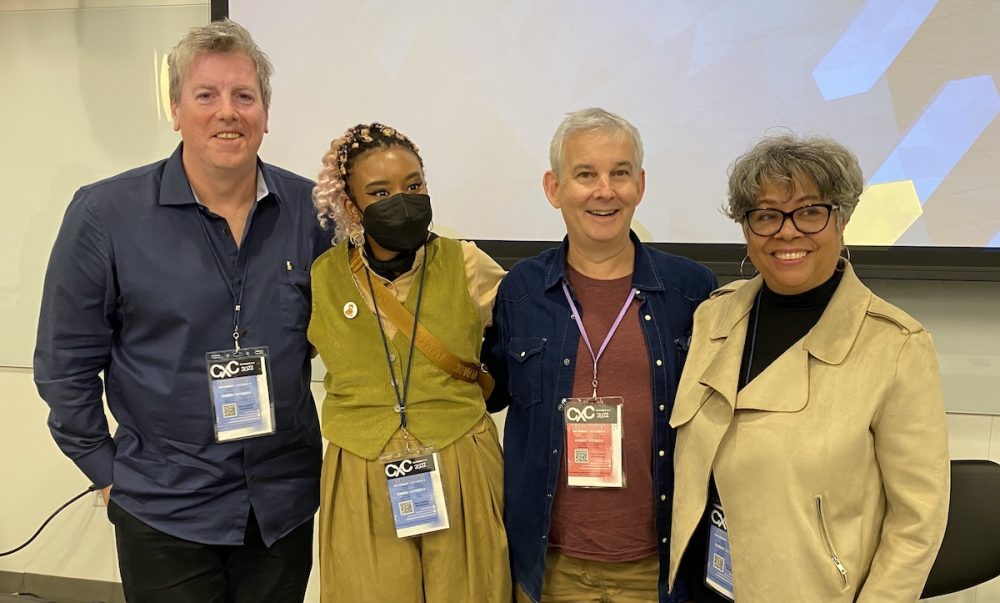
Wolf kicked off the panel, as all panels at CXC did, with a land acknowledgement, and followed with introductions for the panelists. Mentioning the mix of experiences among the panelists, Wolf noted how much syndication has changed over time, and asked how each panelist got into cartooning. Gallagher said he’d always loved to draw, and comes from a cartooning family, as both of his uncles were cartoonists who created Heathcliff. He said at first he was reluctant to join the family business but that after practicing under his uncles for a few years he got more comfortable, until they retired and he took over the strip.
Steenz started on Heart of the City in April 2020, but said they’d been ‘steeped in comics’ for a long time. Working at a comic shop was what led them to realize that making comics was something they could do, particularly seeing other black femme-presenting cartoonists. That was in 2011, and they said it’s been ‘comics comics comics’ ever since.
Keefe spoke about going to art schools after high school at a time when comic books weren’t considered serious literature. When he found out about the Joe Kubert School, he realized there was somewhere he could actually learn to make comics, and his enrollment there led to his becoming a colorist for King Features. He talked about doing fashion illustrations and fill-ins for different features, and eventually pitched for Flash Gordon which is how he got into syndicated comics.
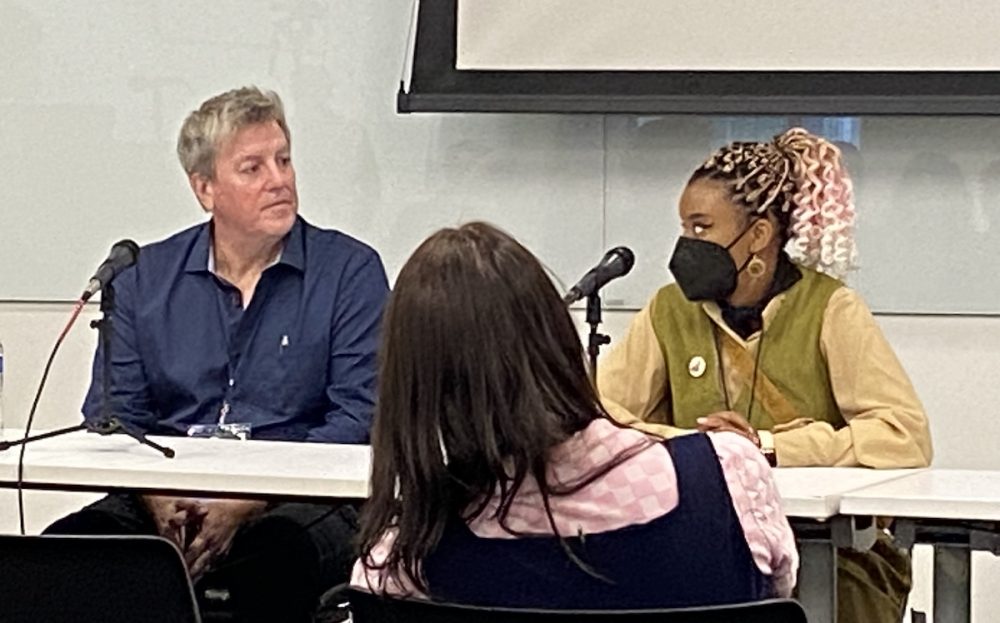
Brandon-Croft joked that she and Keefe are older, so they have longer stories. She said she didn’t grow up knowing she wanted to make comics, but that while trying to get a job at a magazine she took her portfolio and the editor asked her to do a comic strip. She credited her father, Luther cartoonist Brumsic Brandon Jr., for ‘training’ her her whole life, from having her zip-a-tone his comics to filling in on lettering when he was injured. When her father was asked about any other Black cartoonists he knew, he recommended her, and that was when she began pursuing cartooning as a career.
Wolf asked the panelists their favorite and least favorite things about syndication, which is a daily job for years and years. Gallagher said the daily pace used to be his least favorite thing, but that now it’s his favorite. “As I did it more, that’s the thing that made it easier,” he said, saying that having to do it every day meant he just had to put something out no matter what and it freed him up to try new things. He praised his editors at Creators Syndicate for never having said ‘no’ to him when he tries something.
Steenz echoed Gallagher’s answer, saying they never have to worry about their next project, but also that Heart of the City is “always there,” which is daunting. They also credit having to draw every day with having helped them improve as an artist. Talking about the characters aging over time, Steenz said they want to “make sure [the characters] are growing” so that readers can experience that along with the characters.
Keefe said his Sally Forth characters are locked in time as a legacy strip, so he doesn’t get to enjoy that same development that Steenz can. He also said the schedule is grueling, and that to take time off means having to double up work since there’s no vacation time. Keefe also noted the lack of sick time or health benefits as freelancers, which he wants to see addressed more than it currently is. His favorite thing is the national and international reach of the work, with Sally Forth being national and Flash Gordon being an international strip, which brings him a wider range of reader responses.
Brandon-Croft said her situation was different now, as she was syndicated from 1991 to 2005, at a time when she also did a weekly strip on top of the daily strip. She echoed what Keefe said about the hustle required to make it in daily cartooning, and also that the reach of the work is “astounding.” She also joked about starting to age her characters but deciding not to – if she doesn’t like bags under her eyes, her characters wouldn’t either.
Wolf responded briefly to the lack of insurance and the schedule, and acknowledged the changing face of newspapers and young peoples’ ability to put their work online as opposed to the old days of trying to get into papers. The market has changed a lot, she said, and she asked the panelists to expand on the challenges of syndication, particularly in comparison to other spaces. Gallagher said Heathcliff is a full-time job, especially since he does everything himself. A friend at Weird New Jersey magazine asked him to do a strip, and Gallagher described making up gag strips about the Jersey Devil and a sexy tomato. Those strips offered him more freedom than he has with Heathcliff, where there’s just one panel and he has to stick to the character. Steenz praised Heathcliff as “really surreal in the best way.”
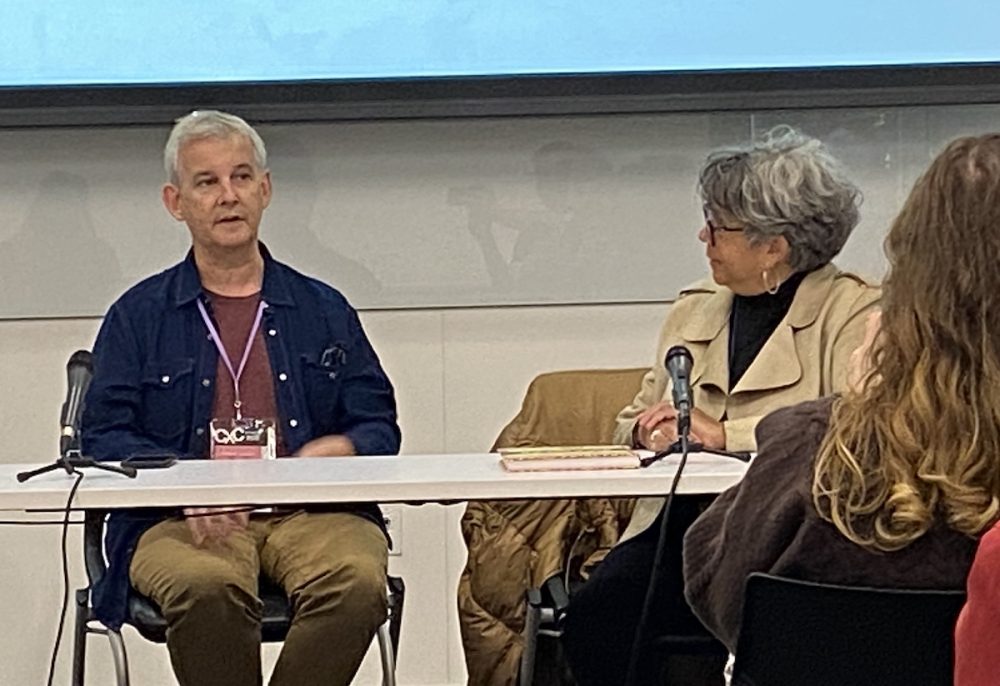
Steenz said the trim size in a comic strip is tight compared to in comics and graphic novels. They said it took them time to get used to that and how to get creative in that format. They also had to figure out what’s okay for a newspaper strip. A story where a character said he’s the cousin of Keanu Reeves was fine, for example, but one where someone finds out the Tooth Fairy isn’t real was more of a topic of concern. They said they just want readers to be able to get a chuckle from their strips, and joked about doing a crossover with Heathcliff, which Gallagher agreed with.
Keefe said he was aware of Weird New Jersey magazine as well. On the subject of what can go into a strip, Keefe said there are a lot of constrictions due to the format, but that when deciding what to put into the strip he described doing a strip with Somali characters in hijabs, which he didn’t think anything of as they are part of the real-life community in which the strip is set. Their inclusion drew criticism from the typical contingent of readers, but Keefe also that he received a nice letter from the mother of a reader who wears a hijab and appreciated seeing that. He talked about how the perspective in comics has shifted in terms of creator demographics, and praised those who have helped broaden the relatability of newspaper strips.
Brandon-Croft spoke about the many rejections she received due to the format of her comics, but that as she became established she was “encouraged to be more daring” in what she put into her strips. She noted only one time that an editor told her not to do something in her strip, but that she did tend to keep things in mind that she’s couldn’t do when she was with a syndicate, but that now that she’s independent she can do whatever she wants.
Wolf gave the panelists a chance to talk about what they’re working on now that’s outside of comic strips. Brandon-Croft said she was contacted by Drawn & Quarterly about doing a collection of her work, with the publishing noting the importance of comics in newspapers especially as that industry is dying off. D&Q will release a collection next year, which she joked is an ‘Origin’ book, and which has given her a chance to tell her story of how she got into comics and to reflect on where she’s been and where she is now, and her place in history. Keefe asked if the book was autobiographical, and Brandon-Croft clarified that it’s a selection of her 14 years of syndicated strips as well as newer work, photos, and personal writing about her career. The book is due out in February.
Keefe said that, inspired by Band of Brothers, he’s been working on a graphic narrative about his father, who served in Patton’s 3rd in World War II. He said he’s been doing research based on material of his father’s that his mother saved.
Steenz said they’ve been working on a book, Side Quest, a graphic novel that examines the history and context around tabletop role-playing games. They’re also working on a mini-comic for Unico, as well as serving on the committee for the St Louis Small Press Expo, which they’re working on getting back going post-pandemic shutdown. They also mentioned Comics University, which they’ve been doing for eight years and would like to start back up again, when they are hypothetically less busy. They also mentioned another project where they immerse themself into hobbies and subcultures they’re not familiar with and learns everything they can about it before attending a convention about it.
Gallagher teaches illustration as an adjunct at Montclair State University, which he said energizes him to keep working. He said he’s also been keeping notebooks for when he’s not working on Heathcliff, and that he wants to put them together somehow. One idea is Space Bros, an action comic drawn in a Jack Kirby-esque style where all the characters ever say is ‘Bro.’ Gallagher also mentioned that he’s working on a Heathcliff compilation.
Opening the floor for questions, a question was asked about how far out in advance the cartoonists work. Steenz said they’re an outlier because they work pretty far ahead. They write their stories in three month chunks, then four weeks ahead they have the dailies completed, and a few weeks ahead they complete the Sundays. They said currently they’re on June of 2023.
Gallagher said his schedule for submitting the work is similar to Steenz’s, but that his work is different because Heathcliff has no plot. Steenz said part of the job is to avoid current events gags since they write so far ahead that by the time the strip comes out the gag might be stale. Keefe said his schedule is a little different since he works with a writer on his current strip, Sally Forth. He reiterated how tenuous the schedule is in case of sickness or other hiccup. Brandon-Croft said her weekly strip was a month ahead, because she would get fined if she was late. Keefe mentioned how Berkeley Breathed was legendarily late on Bloom County.
A final question was asked about each panelist’s favorite syndicated comics. Gallagher cited Jim Unger’s Herman, while Steenz named a number of titles from when they were going up, including Ray Billingsly’s Curtis, Stephen Pastis’s Pearls Before Swine, and Jerry Scott & Jim Borgman’s Zits. As an adult they said blushingly that they’re a big fan of Heathcliff, as well as Tauhid Bondia’s Crabgrass. Keefe said he loves old adventure strips, as well as Peanuts and the work of Charles Schulz. Brandon-Croft cited her father’s work as some of her favorite, as well as the work of Jules Feiffer.


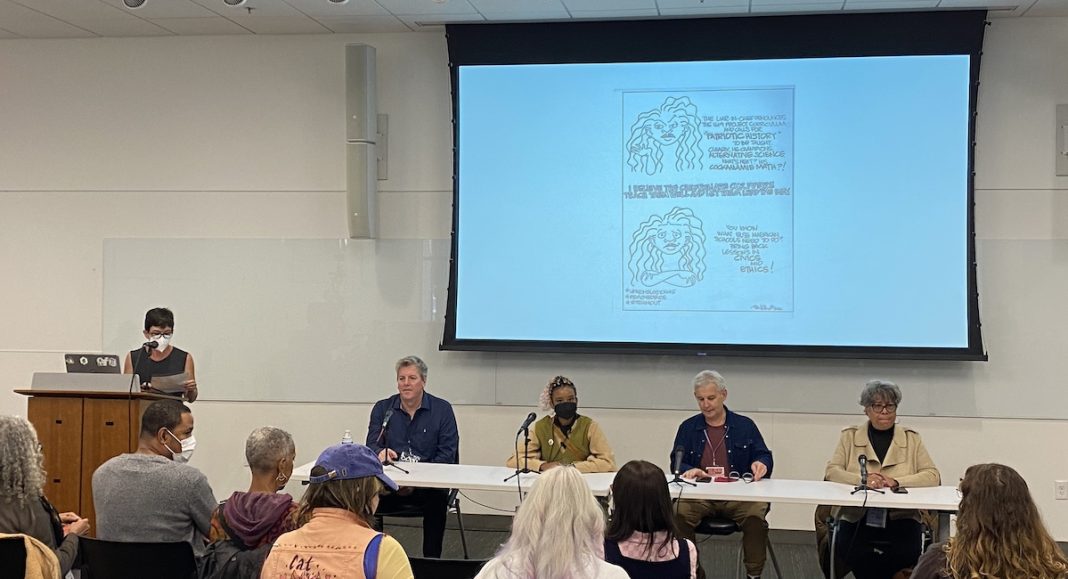
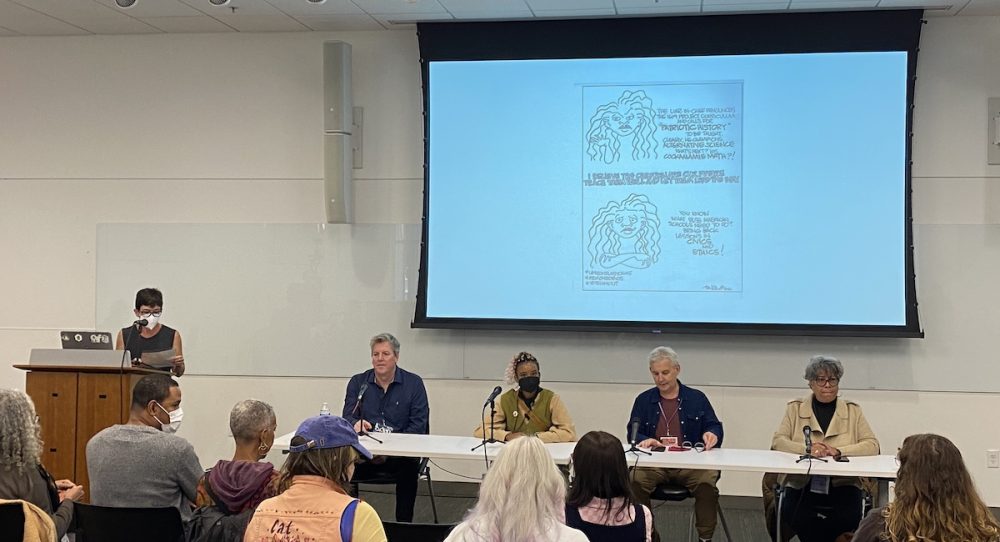
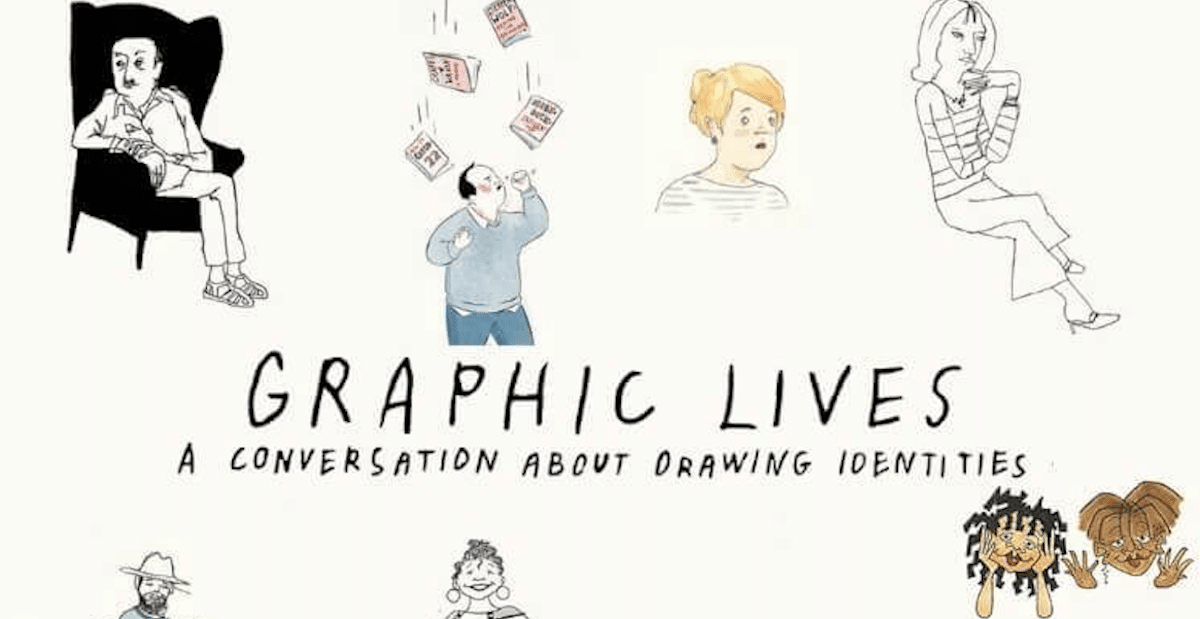




Thanks for the coverage, but Feiffer, not Pfeiffer. He’s one of the greats after all.
Corrected!
Comments are closed.